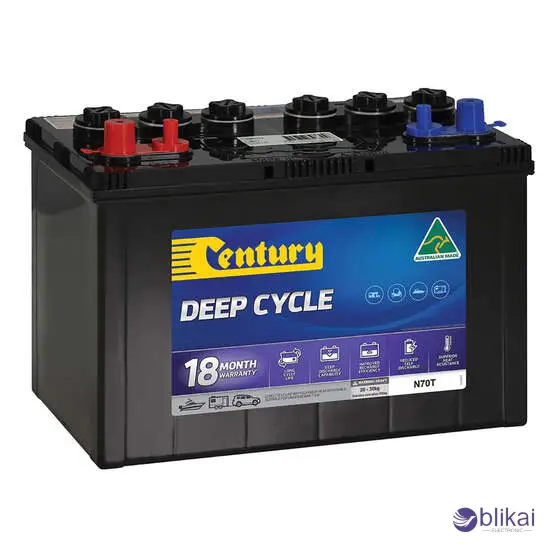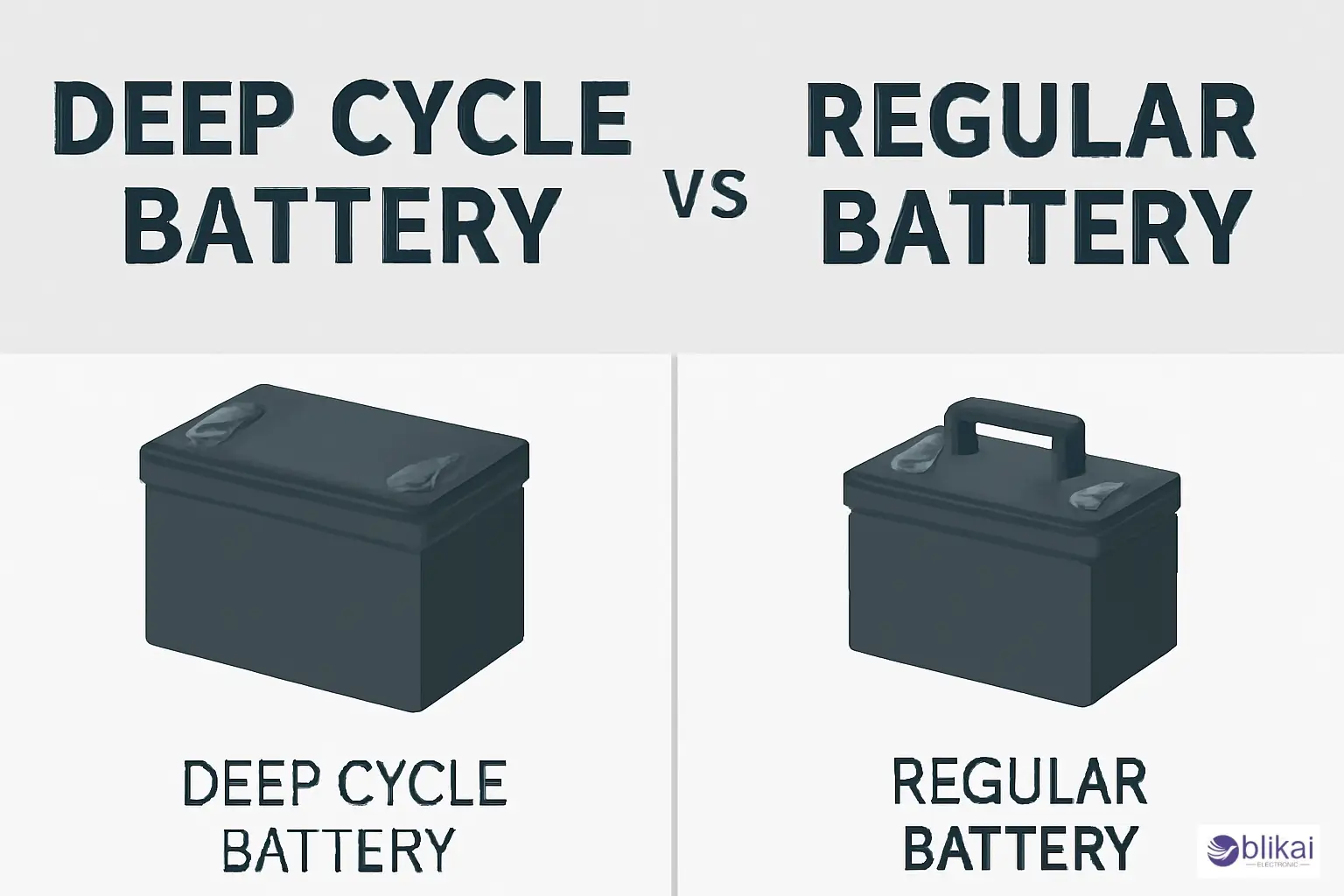Deep Cycle Battery vs Regular Battery: Difference
What is a Regular Battery?
A regular battery is a kind of battery that is meant to give a sudden spurt of high power for a short duration. These are mainly non-rechargeable batteries, though there are rechargeable variants (such as some variants of lead-acid and lithium-ion batteries in special applications).
Pros and cons of regular batteries:
The fact that regular batteries can deliver a substantial power capacity over a limited duration is one of the core benefits of this technology, as it becomes very important in such areas as engine start-up or powering devices with high demand over a short duration. They are very inexpensive, common and come in numerous varieties of sizes and shapes and therefore are simple to locate and utilize. They, however, have a great disadvantage as they are highly discharged and can either need to be recharged or replaced according to the type of battery used. Moreover, they are not always compatible with the use that demands constant and prolonged power because their ability is restricted to short energy surges.
What is a Deep Cycle Battery?
A deep cycle battery is a kind of battery that is particularly aimed at releasing a constant quantity of energy over a long duration. These batteries prove to be worth using in situations where constant and consistent power is necessary over a longer duration, and as such, they are suitable in off-grid power systems and other areas with necessary steady power.

The main peculiarities of a deep cycle battery are that it can be discharged and recharged several times without severe damage to its internal elements. These are constructed with thicker plates and more internal structure to tolerate deep discharges to enable them to be in service even at a lower state of charge of the battery.
Pros and cons of deep cycle batteries:
The primary advantage of deep cycle batteries is their long lifespan and consistent performance over time. Deep cycle batteries can last a few years when well maintained. They can also be used where deep discharges are necessary because they will not be damaged, which makes them perfect for devices or systems that need to be used frequently or continuously. Nonetheless, deep cycle batteries have certain limitations, such as that they cost more than the normal batteries because they are made of more durable materials and design. Also, the deep cycle batteries are commonly heavier and bulkier, which is also a drawback in cases of limited weight and space, like in portable electronics. Their maintenance also needs to be more frequently checked to maintain long life.
Key Differences Between Deep Cycle and Regular Batteries
Discharge Depth
Among the most important differences between deep cycle and regular batteries, it is possible to distinguish the discharge depth. Normal batteries are constructed to emit shallow portions of the total energy capacity. This implies that they offer very short bursts of power that are used on a short-term basis, like starting an engine, and they are normally discharged to approximately 30 percent or 40 percent of their total capacity before they need recharging. Deep cycle batteries, on the other hand, are specially made so that they can be discharged to 20-50 percent of their total capacity without being damaged. This is because they are best used in applications where a device or system requires continuous or extended running time, e.g., storing solar energy or powering an RV.
Design and Construction
Regular batteries, such as those used in vehicles, are built for high cranking amps (CA), which is the amount of power they can provide in short bursts to start an engine. This necessitates a design that has high-output power and is quick, but the design can not work on long, deep discharges. Widely used batteries are normally thinner and lighter built in order to facilitate the fast flow of power needed to start engines. Deep cycle batteries, on the other hand, are built with heavier plates and a stronger internal design. These are the thicker plates that enable the battery to experience a number of deep discharges without being affected by wear and tear that standard batteries would have undergone under the same circumstances. The deep cycle batteries also tend to have more intense electrolyte solutions and internal components in order to facilitate long-term cycling.
Battery Life
The other important distinction is battery life. The usual lifespan of regular batteries is 3 to 5 years, again depending on the use and the maintenance. This is mainly because they are not intended to be used on a full-time basis, and are prone to many charging and discharging processes as time goes by, which may result in loss of internal parts of the battery. Deep cycle batteries, on the other hand, are constructed to endure significantly more charge and discharge cycles so that they can last far longer--usually 6-10 years. This extended life span is explained by the fact that they are designed to deep cycle and be able to provide long-term power.
Power Output
Power output is another area where deep cycle and regular batteries differ significantly. Regular batteries are designed to provide a high burst of power over a short period. This makes them suitable for scenarios that require high cranking power in a short time, like in automotive starting situations. They can provide much energy within a very limited period of time, but they cannot maintain high energy over a long period. Deep cycle batteries, on the other hand, give a lower yet constant amount of power over a significantly extended duration. This feature renders deep cycle batteries more applicable in areas where sustained and constant energy is needed over long periods of use. As an illustration, deep cycle batteries are well-known in an off-grid solar power setup, EVs, and marine applications, where regular power is mandatory, and high power spikes are unnecessary.
Applications of Deep Cycle Batteries vs Regular Batteries

Deep Cycle Battery Applications
Another typical application of deep cycle batteries is in off-grid power systems. These systems are usually located in isolated locations or where their users desire to be energy independent. They use deep cycle batteries, which are used to store the energy produced by renewable energy sources like solar power or wind power. Deep cycle batteries have the capability of giving out a lot of energy consistently with ease, making them a perfect solution to store energy to be utilized when the sun or wind is not available. Also, deep cycle batteries find application in marine applications, especially in boats and yachts. These batteries play an important role in supplying power to a number of onboard systems, such as lights, water pumps, and electronics, as well as their ability to serve extended usage without deteriorating performance. EVs (golf carts, electric bikes and even some low-speed electric cars) also frequently use deep cycle batteries.
Regular Battery Applications
A frequent application of regular batteries is in consumer electronics, e.g., in TV remotes, clocks, and other portable devices such as flashlights and toys. These gadgets need a burst of energy in order to operate, yet do not need a constant source of power. The normal batteries are also needed in automobile usage, where they are mostly utilized to start the engine. An example is car batteries, which are being used to supply high cranking amperage (CA) to start the engine, but after the engine is started, the alternator is used to power the systems in the vehicle.
Conclusion: Which One is Better?
There is no situation where one type of battery is necessarily better than the other, but the two types of batteries are equipped with different advantages, depending on the context of use.
Normal batteries are used in tasks that need temporary high power impulses within a limited period of time. When you need to propel some kind of engine, you have some kind of remote control, or you need to provide some short shots of power to some kind of electronic device, a regular battery would be more suitable. They are also cheaper to purchase initially and more accessible, and thus more cost-effective in terms of a device that does not need to be supplied with power on a long-term basis.
Deep cycle batteries, on the other hand, are meant to power the long run. They are designed to deal with a high number of deep releases and during long durations of time, which is why they are useful in solar energy storage, electric cars, and in the sea. They also have a longer life span, particularly when used in hard duty, and they might be costly at the start, but they can be more rewarding in the end since they are durable and long-lasting.
In the end, neither battery is necessarily better, and the better one is, it depends on your scenario.
FAQ
What is the key distinction between regular and deep cycle batteries?
The standard batteries offer short bursts of electricity over a short time, which is suitable where starting vehicles is required. Deep cycle batteries, conversely, provide low low-volatility power supply with extended operation, thus appropriate to off-grid, or electric vehicles.
What is the life expectancy of deep cycle and regular batteries?
Batteries are generally 3-5 years in duration for regular and 6-10 years in case of deep cycle, depending on the usage and maintenance.
Is it possible to use a deep cycle battery in a car?
Although deep cycle batteries may be utilized in automobiles, standard batteries are typically used in automobile engines because of the high cranking amps that are provided during a momentary power burst.
Some images are sourced online. Please contact us for removal if any copyright concerns arise.
CR3032 Battery: Specs, Applications & Comparisons Explained
CR1025 Battery: Specs, Replacements & Common Applications
4680 Battery Explained: Next-Gen Power Cell
26650 Battery vs 18650 Battery: Key Differences
All About the 96R Battery: Applications, Maintenance & Safety Tips
18500 Battery: Features, Applications & Comparison
L1131 Battery Equivalent: Features & Applications
Battery Desulfator: How It Works & Why It Matters
A27 Battery: Lifespan, Applications & Alternatives
CR2477 Battery: Features, Applications & Lifespan










